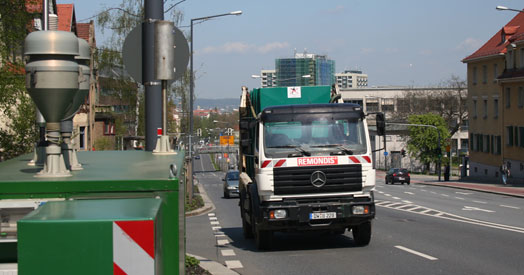Anke, K.; Sähn, E.; Klingner, M.: Pilotprojekt zur Auswertung von Immissionsdatensätzen auf Basis von Screeningfunktionen. Im Auftrag des Sächsischen Landesamtes für Umwelt und Geologie. Dresden, September 2002.
Anke, K.; Klingner, M.; Sähn, E.; Löschau, G.: Screeningverfahren und Immissionsmodelle zur Auswertung von PM10-Langzeitmessungen. In: Gefahrstoffe - Reinhaltung der Luft 05/2003, Springer-VDI-Verlag, S. 201-208.
Anke, K.; Illgen, A.; Sähn, E.; Klingner, M.: Auswertung von Immissionsdatensätzen aus automatischen Messstationen in Baden-Württemberg auf Basis von Screeningfunktionen. Im Auftrag der Landesanstalt für Umweltschutz Baden-Württemberg, November 2003.
Anke, K.; Sähn, E.; Klingner, M.: Statistische Quellgruppenanalyse für die PM10-Belastung in sächsischen Ballungsräumen. Im Auftrag des Sächsischen Landesamtes für Umwelt und Geologie. Dresden, Mai 2004.
Anke, K.; Sähn, E.; Klingner, M.; Wolf, U.: Intensität und Nachwirkung meteorologischer Einflussfaktoren auf die PM10-Konzentration. In: Gefahrstoffe - Reinhaltung der Luft 1/2-2005, Springer-VDI-Verlag, S. 41-48.
Anke, K.; John, D.; Sähn, E.; Klingner, M.: Quellgruppenanalyse für Schwebestaub und Stickoxide in Ballungsräumen Baden-Württembergs. Im Auftrag der Landesanstalt für Umweltschutz Baden-Württemberg, Mai 2005.
Anke, K.; Sähn, E.; John, D.; Klingner, M.: Hierarchische Gliederung von Überschreitungsepisoden - erweiterte und detaillierte Analyse für Schwebstaub (PM10). Im Auftrag der Landesanstalt für Umweltschutz Baden-Württemberg. Dresden, Dezember 2005.
Klingner, M.; Sähn E.: Auswirkungen ordnungsrechtlicher Verkehrsmaßnahmen auf die lokale Feinstaubbelastung unter Berücksichtigung meteorologischer Einflüsse. Im Auftrag des Bundesministeriums für Verkehr, Bau- und Wohnungswesen, Februar 2006.
Klingner, M.: Feinstaub - Datenscreening und Prognose. FVV-News 02/06.
Klingner, M.; Voigtländer, M.; Anke, K.; Sähn, E.: Entwicklung eines Prognosemodells für PM10 als Instrument für Aktionspläne. Im Auftrag des Sächsischen Landesamtes für Umwelt und Geologie. Dresden, April 2006.
Sähn, E.; John; D.; Klingner, M.: Ermittlung und Archivierung von online verfügbaren PM10-Immissionsdaten deutscher und
europäischer Ballungsräume. Im Auftrag der Forschungsvereinigung Automobiltechnik e.V., Juli 2006.
Klingner, M.; Sähn, E.; Anke, K.; Holst, T.; Rost, J.; Mayer, H.; Ahrens, D.: Reduktionspotenziale verkehrsbeschränkender Maßnahmen in Bezug zu meteorologisch bedingten Schwankungen der PM10- und NOx-Immissionen. In: Gefahrstoffe - Reinhaltung der Luft, Juli/August 2006, Springer-VDI-Verlag, S. 326-334.
Sähn, E.; Klingner, M.: Modellgestützte Bewertung der Wirkung ordnungsrechtlicher Maßnahmen auf die Feinstaubbelastung. METTOOLSVI, Garmisch-Partenkirchen, 24.-26. April 2007
Klingner, M.; Sähn, E.: Einfluss von Verkehrsparametern auf die Immissionsbelastung in Ballungszentren. Professur für Verkehrsleitsysteme und -prozessautomatisierung der Technischen Universität Dresden, 3. VIMOS-Tagung, Dresden, 12. Dezember 2007
Klingner, M.; Sähn, E.: Möglichkeiten und Grenzen verkehrsbeschränkender Maßnahmen zur Einhaltung der zulässigen PM10-Tagesgrenzwerte in der Stadt Ulm. Im Auftrag der IHK Ulm, 2007/2008
Klingner, M.; Sähn, E.: Prediction of PM10 concentration on the basis of high resolution weather forecasting. Meteorologische Zeitschrift, Volume 17, Number 3, June 2008, pp. 263-272
Rost, J.; Holst, T.; Sähn, E.; Klingner, M.; Anke, K.; Ahrens, D.; Mayer, H.: Variability of PM10 concentrations dependent on meteorological conditions. International Journal of Environment and Pollution (IJEP) 2009 - Vol. 36, No.1/2/3, Inderscience Publishers, Geneve, Switzerland, pp. 3-18
Klingner, M.; Sähn, E.: Umweltzonen gegen NOx – gleicher Modus, mehr Erfolg?. Im Auftrag der IHK Ulm, 2010
